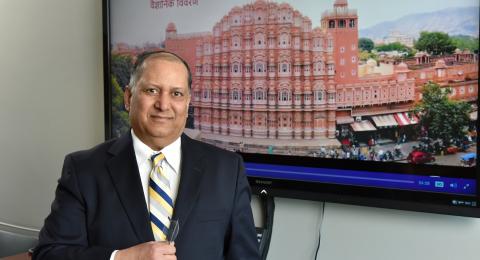Oswego professor, scholarly team produce 28 science-themed videos to teach Hindi
Office of Communications and Marketing
Published
Dr. Alok Kumar, distinguished teaching professor of physics at SUNY Oswego, had an idea to pitch to the National Security Agency: a series of videos about famous archaeological sites and institutions in India, with accompanying lesson plans, to teach Hindi internationally in the context of science and technology.
The NSA-funded program STARTALK makes it a national security priority to expand the teaching and learning of Hindi, Arabic, Chinese and other world languages. The program made a $90,000 grant to Dr. Ved Chaudhary, director of the project, supplemented by funding from his New Jersey-based foundation, Educators’ Society for Heritage of India, with Kumar as principal investigator.
The financial support enabled Kumar to work with a team of scholars in New Jersey, Jaipur and New Delhi, where they produced 28 videos in India's majority language.
The videos -- there are as yet no versions with English subtitles, but Kumar hopes to accomplish that -- focus on scientific innovations at such sites as the Amer Fort palace in Jaipur, the rust-resistant Iron Pillar of Delhi, the Qutub Minar UNESCO World Heritage Site, the Chand Bawri step well, the Hawa Mahal "air palace" in Jaipur and even the headquarters of the Jaipur Foot, a prosthetic given free to impoverished amputees in 80 countries of the world.
"This was a unique experience. I never knew I was going to have so much fun doing my research," said Kumar, who has published several books on ancient Hindu science, mathematics and medicine. "I met a number of high-quality individuals who have made a profound impact on my life."
Supported by research studies, Kumar said, context is crucial in learning new languages. Each video -- designed for learners from middle school through college -- employs a STEM (science, technology, engineering and math) perspective "to provide interesting and incredibly rich context to create learning experiences that can push learners to the advanced level of Hindi."
Rich heritage
The NSA-funded STARTALK grant program is administered by the National Foreign Language Center at the University of Maryland. In a STARTALK project unrelated to Kumar's, SUNY Oswego history faculty member Ming-Te Pan and modern languages and literatures' Ching Hung Hsiao host the Chinese Language and Culture Summer Camp each July for students in grades 2 through 12.
For his project, which spun off several books he has written, Kumar decided to combine the learning of Hindi with visual information, narration and interviews with experts about India's rich heritage in science, technology, architecture and theology.
A grant from the non-profit Educators Society for Heritage of India financed production costs -- including travel -- in India, where Kumar made two trips, one with a cameraman. The working journeys opened his eyes to how "very, very expensive" video production can be.
Perhaps Kumar's most moving experiences came at BMVSS in Jaipur, where Dr. Devendra Raj Mehta has done award-winning work for more than 40 years to design and fit poor people with artificial limbs -- including the Jaipur Foot -- and other aids and appliances.
A scene in one video shows an athletic below-the-knee amputee strapping on the Jaipur Foot, then running, climbing a tree and jumping down before an enthusiastic greeting from a beaming Kumar.
Mehta's work -- now expanded to Afghanistan, Pakistan and scores of other countries -- provides a valuable lesson about Hindu theology: "You must give the very best that you can afford to give. All human beings have dignity, and you must respect that," Kumar said.
Scientific innovation
Science-based innovations abound in the sites Kumar chose. With no air conditioning in 1799, a Hindu architect designed the honeycomb-patterned Hawa Mahal as a "Palace of Breezes," taking advantage of what is known as the "Venturi effect," said Kumar. Air enters narrow passages of the building, increasing the speed of flow and producing natural cooling.
The nearly 24-foot-tall Iron Pillar of Delhi, built in the year 402, is a testament to the skill of Hindu metalsmiths who processed phosphorus-rich iron that, instead of corroding, creates an even, protective layer that has withstood centuries of monsoons and scorching summer heat.
Though he won't be working on any new videos this summer -- "We are in analyzing mode to see what the impact is" -- Kumar said he is by no means done.
"It was a neat project, and I have lots more video ideas," he said. "I'm getting offers of help from all different corners. This is going to grow."
Kumar is the author of "Sciences of the Ancient Hindus: Unlocking Nature in the Pursuit of Salvation," "Ancient Hindu Science: Its Transmission and Impact on World Cultures," and, with co-author Scott L. Montgomery, "A History of Science in World Cultures: Voices of Knowledge."
The collection of videos Kumar and team produced can be viewed at https://startalk.umd.edu/public/AuthenticMedia_IndianScienceTechnology.



